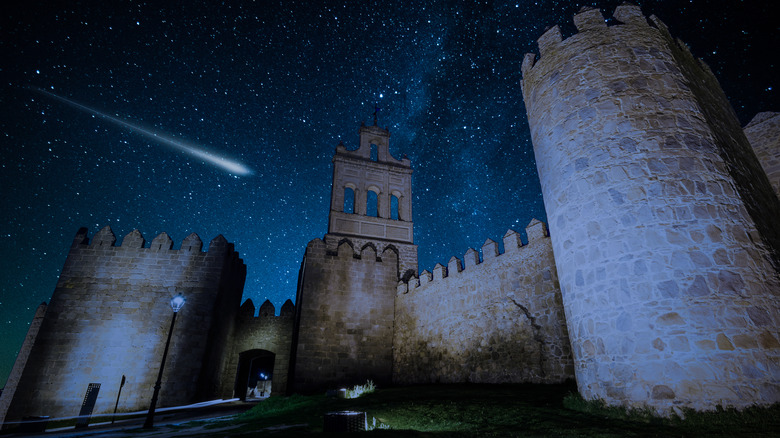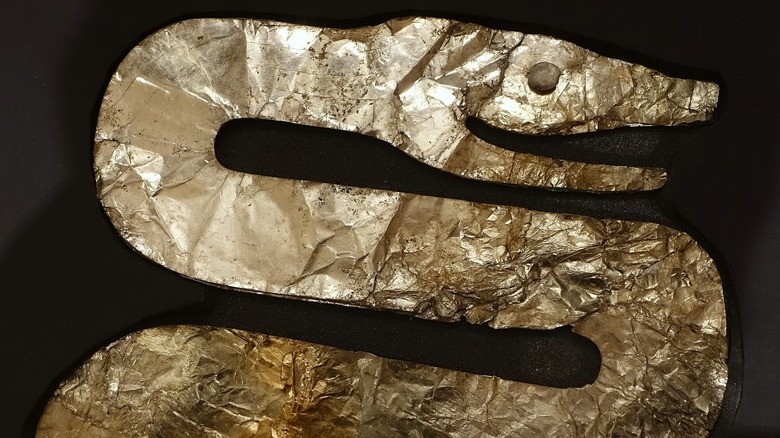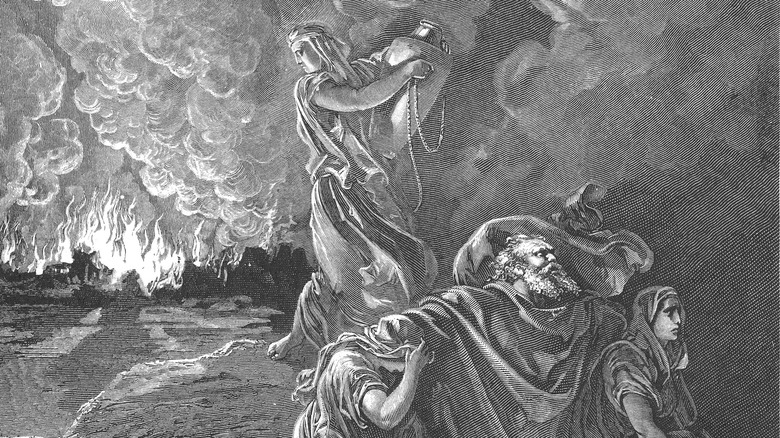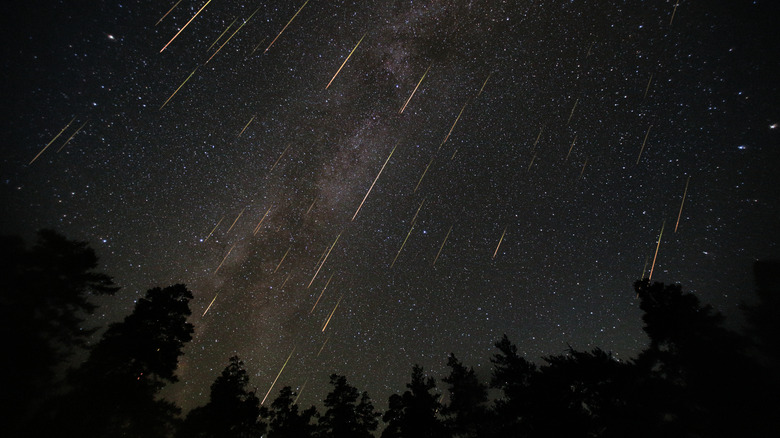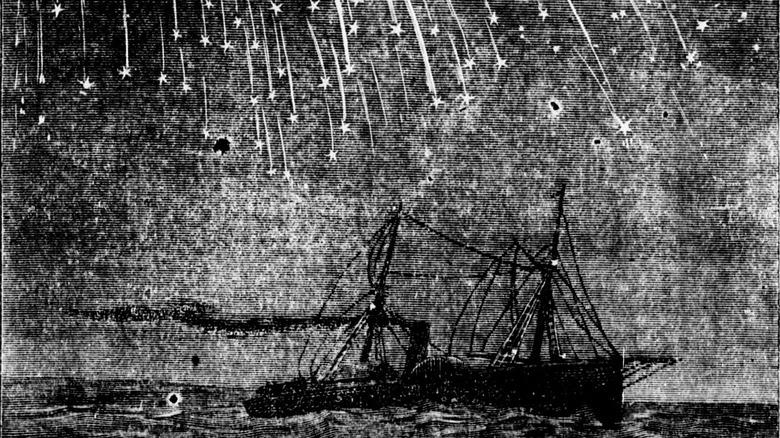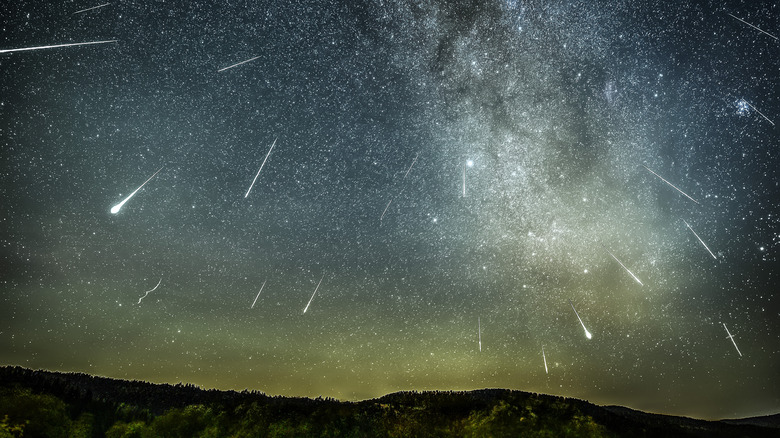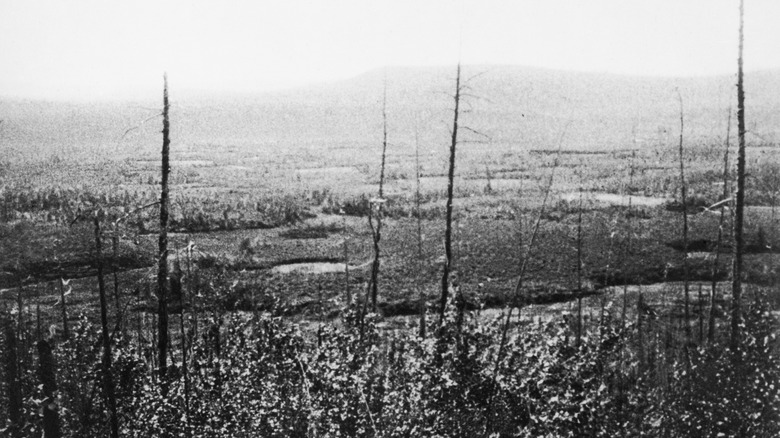People Throughout History Who May Have Been Killed By Meteorites
Every day, an estimated 48 tons of meteoritic material falls onto Earth, although most of it burns up in the atmosphere, causing shooting stars. Space, it seems, is a surprisingly cluttered place. There are over 30,000 near-earth asteroids in the solar system, and Earth still bears the scars from several colossal asteroid impacts in the past. For smaller space rocks like meteoroids, there are certainly countless more out there. An average of 17 meteorites crash onto Earth's surface every day and, per Slate, the odds of being killed by one are about 1 in 700,000. Statistically, that makes death-by-meteorite more likely than winning the lottery.
To date, only one person has ever been officially killed by a meteorite, documented in historical records from 19th-century Iraq. However, history is full of unconfirmed reports of such incidents. While they may not always be considered credible, there's a good chance that falling chunks of space rock have been responsible for numerous deaths throughout history, and even in prehistory.
Fortunately, not all close encounters of the rocky kind are fatal. There are plenty of accounts of near misses too. In 1794, a meteor knocked the hat off an Italian child's head, leaving the child completely unharmed. More recently, in 2021, a Canadian woman was rudely awakened when a meteor smashed through her roof and landed on her pillow while she was sleeping! Many, however, have not been so fortunate, like when a meteor exploded over Russia in 2013, injuring over a thousand people.
Prehistoric calamities
The oldest evidence of deadly meteorite impacts predates written history, coming not from historical records but from archaeological findings. Perhaps the oldest example is the ancient village of Abu Hureyra in Syria, according to a study in Scientific Reports. Researchers analyzed the site and found the telltale fingerprints of a cosmic impact which likely destroyed the village around 12,800 years ago. The culprit may have been an airburst — an event when a meteor explodes or fragments while in Earth's atmosphere, potentially causing devastation on the ground below. In the case of Abu Hureyra, the devastation in question caused a decline in the population of prehistoric humans and contributed to the extinction of some ancient megafauna.
Airbursts can have disastrous ecological effects, which have seemingly killed plenty of people indirectly too. Around 1,500 years ago, one such event is believed to have decimated a network of Native American tribes known as the Hopewell Culture. While there are no records of whether there were direct casualties, the event caused severe damage to agriculture in the area. Severe enough, that it caused the decline of an entire civilization. Evidence for this can also be found in the oral histories of several Native peoples in North America today. Among others, the Myaamia have a story of a horned serpent raining stones down from the sky, and an Ottowa history mentions a day when the sun fell down to Earth.
[Featured image by Daderot via Wikimedia Commons | Cropped and scaled | CC BY-SA 4.0]
Divine judgement in the Bible
Perhaps the oldest written accounts of death-by-meteorite can be found in the Hebrew Bible, which would later become the Christian Old Testament. The first was likely inspired by the ill-fated city of Ell el-Hammam, a Bronze Age city near the Dead Sea. According to a study in Scientific Reports, the airburst that destroyed it around 1650 B.C.E. was larger than the one which caused the famous Tunguska Event (more on that later). The researchers hypothesize that this was first remembered in oral histories, later becoming the story of the ill-fated city of Sodom. Genesis 19:24-25 reads, "Then the Lord rained upon Sodom and upon Gomorrah brimstone and fire [...] And he overthrew those cities, and all the plain, and all the inhabitants of the cities, and that which grew upon the ground."
Another account comes from the Book of Joshua, the 6th book in the Hebrew Bible and also part of the Old Testament. Joshua 10:11, describing the Battle of Gibeon, says "the Lord cast down great stones from heaven upon them unto Azekah, and they died." It pointedly says that more were killed by falling stones than by the battle itself. The story reportedly dates back to around 1420 B.C.E. and, while it's difficult to say if it's an account of a real event, it certainly sounds like a description of an airburst and falling meteorite debris. Similar deadly events have been recorded throughout history, and this isn't the only one to have reportedly struck a battlefield.
The unfortunate Chinese rebels
Of all countries in the world, China has the longest continuous history, with detailed writings going back around 3,500 years. Covering such a long time, the Ancient Chinese noted several written records that appear to describe cosmic impacts, and one significant one comes from the final years of the Sui Dynasty. At the time, most of China was in open rebellion against their rulers, ultimately causing the dynasty to fall in the early seventh century. A historical record commissioned by the Chinese emperor, the Book of Sui, is considered a reliable account by historians. As well as documenting the dynasty's demise, it describes a meteorite striking a battlefield in 616 C.E.
It's mentioned by a study in the journal Meteoritics, with a description of a meteorite striking a group of attacking rebels. Seemingly, it must've been a sizeable object, destroying a rebel siege tower and killing 10 people — though it's unclear whether the deaths were directly caused by the meteorite or by the falling tower. It was described as "a large shooting star" which fell on the encampment of a rebel leader named Lu Mingyue. However, it's also a little uncertain how much truth there is in the story. The account was written by the emperor's scholars, and it feels exceptionally lucky for their enemies to have been struck down by a stray space rock, leading some historians to consider this may have actually been written as a form of ancient propaganda.
The Qingyang storm of stones
In 1490, Ming Dynasty history books recorded a catastrophic event in the city of Qingyang, in China's Gansu province. The so-called storm of stones saw rocks falling "like rain" from the sky, with sizes varying between a water chestnut and a goose egg. A paper in the journal Meteoritics suggests this bombardment may have been caused by an airburst as a large meteor crumbled while entering Earth's atmosphere, resulting in a shower of fragments pummelling anything below. No official death toll was ever recorded from this very literal meteor shower, but one source suggests there may have been tens of thousands of fatalities. If correct, this would make the Qingyang event the deadliest meteor impact ever recorded.
The same year, Chinese astronomers were the first to discover a comet in the sky, now believed to be responsible for the annual Quadrantid meteor shower. Its official name is C/1490 Y1. Earth's handful of annual meteor showers happen as our planet passes through trails of debris left in the wake of comets, as they cross Earth's orbit to swing by the Sun. The Quadrantid stream, though, seems to have been formed quite recently, and astronomers have also discovered an asteroid orbiting in its same path. This chunk of space rock may be a fragment of some violent event that caused the Quadrantid meteor shower. Though it's difficult to say whether this had anything to do with the stones which fell on Qingyang, it seems quite a coincidence.
The Shanxi disaster
It's quite likely that there may have been many more meteorite incidents than those that history has kept track of. It's noteworthy that the ones we do know of from days gone by were all from places known for keeping careful track of events. Chinese scholars have always kept just such highly detailed historical records, and this includes extensive records of meteor falls. Per a presentation at the International Meteor Conference, over 200 meteors were recorded between 1019 and 1911, but the overwhelming majority of those were completely harmless.
One deadly one, however, happened in 1639, in the middle of the Ming Dynasty. One source mentions a large stone, but another suggests it may have actually been several, perhaps again as an airburst. Either way, the fall was sudden and completely unexpected, crash landing on a market street in Shaanxi province. According to records, the fall damaged numerous houses, shattering brickwork and killing tens of people.
Misfortunate monks
During medieval times, monasteries were known for keeping extensive records, and there have been a couple of recorded incidents of Italian monks being struck down by falling space rocks. One such event happened in 1511 when a shower of falling stones was reported to have killed several birds, at least one sheep, and one member of the monastic order. The written account describes how "unheard-of thunders, mingled with awful lightnings, resounded through the heavens." The entire meteor shower reportedly lasted for around two hours as the landscape was peppered by stones the size of eggs falling from the sky.
Another incident, less dramatic but evidently no less deadly, happened around the middle of the 17th century when a Franciscan monk in Milan was struck on the leg by a meteorite. He reportedly died shortly afterward. The event was largely discounted until the 1980s when a pair of researchers found a written account by the doctor who treated the monk. From the written account, when the meteorite struck the unlucky man's leg, it severed his femoral artery causing him to quickly bleed to death.
[Featured image by Rama via Wikimedia Commons | Cropped and scaled | CC BY-SA 3.0 FR]
Lost at sea
There have been a few incidents of unlucky sailors being killed by meteorites while out at sea, with the book "Comets and Meteors" noting a pair of Swedish sailors killed by a falling space rock in 1674. Elsewhere, Astronomy Magazine mentions another, similar event in which two Dutch sailors were also killed at sea by a meteorite. The unlucky pair were out on the Indian Ocean when an 8-pound meteorite struck their ship, the Malacca. This event happened in 1648 and was not publicized until 20 years later when the captain wrote down his recollection of the events. It seems like quite a coincidence that two such similar events happened so close together in history, and there's a chance these might mistakenly refer to the same event. But there's also the possibility that what struck the Dutch sailors wasn't a meteorite at all. Scientists have noted that there were at least 20 active volcanoes on the route between Europe and East Asia at the time, and they may have been hit by a volcanic bomb — a piece of rock hurled high into the atmosphere by a volcanic explosion.
More sailors were indirectly killed in 1908 when a meteorite smashed a hole in the hull of their ship. Unable to make repairs while at sea, the crew spent nearly two weeks attempting to bail out their vessel while they tried to reach safety. Three sailors died before the ship was finally able to take refuge in Hawaii.
An unlucky French farmer
One of the most dramatic and terrifying meteorite deaths happened in rural France during the 18th century. In 1790, a large meteorite fell on the commune of Roquefort in Southern France, near the city of Toulouse. An old paper in the Philosophical Magazine explains that the falling meteor crushed an entire farmhouse, killing the farmer who lived there as well as several cattle. People arriving later discovered a crater 5 feet deep. Several other meteorites reportedly also crashed into France that evening but, mercifully, no other fatalities were reported.
Managing large tracts of land, farmers have witnessed many meteor falls, though it's likely plenty of them have gone unrecorded. Some aren't even noticed or recognized, like one instance of a meteorite that was used by a Spanish farmer to cure ham until he learned of its extraterrestrial origins. A few recent but less lethal incidents have also included a meteor that landed in an Indian rice field in 2019 and a Californian farmer who had a lucky escape in 2022. According to The Telegraph, his home was struck by an object described as a "flaming basketball." The farmer himself didn't actually see the object. He was at home at the time and didn't notice anything until he discovered his porch on fire. The resulting blaze destroyed a truck and a trailer, and killed a dog.
[Featured image by Reprodukcja własna via Wikimedia Commons | Cropped and scaled | CC BY-SA 4.0]
Meteors falling like rain in Iraq
The most credible known account of a death caused by a meteorite comes from old documents dating back to the Ottoman Empire, according to a study published in Meteoritics & Planetary Science. On August 22, 1888, a meteor storm struck the city of Sulaymaniyah in Iraq. According to the records, meteors rained down onto the city for around 10 minutes, killing one man and severely injuring another. Three letters, discovered in the Turkish State Archives, describe what sounds like an airburst event. A large fireball was seen in the sky nearby, before exploding into a shower of stones. As well as the human casualties, it also did serious damage to the crops in nearby fields.
Seemingly a recovered fragment of one meteorite was also enclosed together with one of the letters, but it seems to have since been lost. With millions of old Ottoman documents having been digitized in 2020, it's likely there may yet be further information on the Sulaymaniyah meteor fall still waiting to be discovered.
The Tunguska event
Perhaps the most famous cosmic impact in recent history was the Tunguska event. Most likely an airburst, this happened when an unknown object fell in 1908 over Siberia in Russia, exploding in the atmosphere with an estimated force of 15 megatons of TNT — a thousand times more powerful than the atomic bomb dropped on Hiroshima during World War II. This devastated an area of around half a million acres of pine forest, leaving felled trees and charred wood in its wake. The Tunguska event is still quite mysterious, having left no crater and with only a few tiny fragments having been found of whatever caused it. Some speculate that it may have been a small comet rather than a meteor. There were plenty of eyewitnesses to the event, which was visible some 500 miles away from the impact site. A few reported seeing a fireball and feeling a hot blast of wind as an atmospheric shockwave knocked people off their feet.
According to a study in Icarus, at least 30 people were inside the blast area of the Tunguska event when the impact happened. Three were killed by it, although none were struck directly by falling material. Instead, they were most likely victims of the shockwave which followed the event. The same shockwave made many of the others lose consciousness. People outside the area reported that they'd felt the ground tremble, and the shockwave was even picked up by seismographs as far away as Western Europe.
The Indian meteorite that wasn't?
The most recent reported meteorite fatality happened in the Indian state of Tamil Nadu in 2016. At an engineering college, an unexpected blast left a crater in the ground and shattered nearby windows, seriously injuring a bus driver. He was rushed to hospital but died before he arrived. The blast also injured two gardeners and a student, and officials initially suspected it was caused by an explosive charge. However, when they found no evidence of explosives on the scene, they began to consider the possibility that it may have been a meteorite, even recovering a fragment of what they believed to be the culprit.
Scientists from the Indian Institute of Astrophysics soon arrived to investigate and gather samples, but later studies found that things didn't quite add up. An official statement from NASA scientists (via NPR) said that it likely wasn't a meteorite at all. From photographic evidence, experts concluded that the event was a closer match to a ground-based explosive, explaining that to leave a crater of that size, a meteorite would need to weigh several kilograms — large enough that it should've easily been found. To date, no conclusive evidence appears to have been reported either way.
[Featured image by McKay Savage via Flickr | Cropped and scaled | CC BY 2.0]
